|
Report from
Europe
German wood consumption rises rapidly, but tropical
timber rapidly loses share
Analysis of the timber market in Germany, which plays
central in the European wood products sector, highlights
the extent to which tropical wood is losing market share,
with important implications for the long-term future of
tropical wood demand in the broader European market.
Germany is Europe¡¯s largest economy with GDP likely to
have exceeded US$4 trillion for the first time in 2018
(according to IMF), over 40% more than the UK, Europe¡¯s
second largest economy.
Germany is Europe¡¯s largest producer of sawnwood and
wood-based panels, with output of 22 million m3 and 11
million m3 respectively in 2017 (according to FAO).
Germany is also Europe¡¯s largest consumer (annually €9.4
billion) and second largest producer (annually €7.3 billion)
of wood furniture. Germany¡¯s annual per capita
consumption of wood furniture is €118, second only to
Luxembourg amongst European countries.
Germany weathered the economic storms of the last
decade better than most other European economies.
Although GDP growth slowed in the second half of last
year as Germany¡¯s large export-oriented manufacturing
sector came under pressure from cooling demand in
overseas markets, domestic consumption in Germany has
been very resilient.
Germany¡¯s domestic market has benefited from strong
consumer confidence, which has remained much higher
than in other European countries in recent years, bolstered
by a low and declining unemployment rate (which fell to
only 3.1% in February 2019) and the expansionary policy
of the European Central Bank which has combined low
interest rates with quantitative easing.
In 2019, domestic consumption in Germany is expected to
remain high, particularly as the German government has
introduced further fiscally expansionary measures,
including a higher minimum wage to help offset an
anticipated slowdown in export demand for German
products. Economic indicators this year have revealed
further rises in consumer sentiment and the composite
Purchasing Managers Index showing better business
conditions.
Feedback from hardwood traders in Germany indicates
that there is good activity in the door and kitchen sectors.
Furthermore, German importers continue to sell significant
volumes of hardwood into the expanding furniture and
joinery manufacturing sectors in Eastern European
countries, notably Poland and Lithuania.
The successful 2019 edition of IMM-Cologne interior
design fair held in January confirmed that underlying
market sentiment in Germany is good and, with strong
growth in overseas visitors, highlighted once again that
Germany is viewed as a major global leader both in wood
product design and innovative processing.
A commentary on material preferences by the fair
organisers noted that ¡°wood is simply invincible¡± because
¡°it is not only sustainable, but also cosy, healthy and
versatile¡±.
The fair suggested a particularly strong preference for
natural wood to be used ¡°as raw as possible: not coarse,
but un-smooth" and that, while paler monotone colours are
still very fashionable, there is a growing trend for ¡°warm
colours tending to dark that harmonise with reddish
wood¡±.
On the surface, all this should imply good opportunities to
increase sales of tropical timber in Germany. However, in
practice, the market has been moving decisively against
tropical hardwood for some time. This is clear from data
presented by Rupert Oliver, Trade Analyst to the FLEGT
Independent Market Monitor (IMM) project (hosted by
ITTO), to the GD Holz ¡°Foreign Trade Day¡± on 4 April.
Overall the data shows that Germany is importing large
and growing quantities of timber products. Should the UK
leave the EU, an event now scheduled to happen by 31
October 2019, Germany will become by far the largest
single EU importer of wood products from outside the
bloc (Chart 1).
However, most of the gains in German imports are being
made in softwoods, particularly from Russia and other
European countries. Furthermore, where Germany is
importing tropical timbers, direct purchases from the
tropics are falling rapidly and more is being purchased
indirectly from importers elsewhere in the EU. This has
important implications for future development of policy
measures like FLEGT and EUTR.
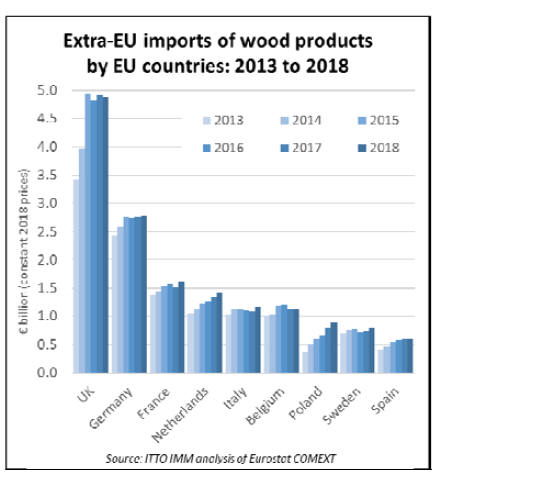
Germany imports around 8 million m3 of logs every year,
but much is low grade, mainly softwood, material for
manufacture of panels and other industrial applications.
Around 90% of all Germany¡¯s log imports derive from
other EU countries.
In 2018, Germany imported only around 400,000 m3 of
hardwood logs, of which 330,000 m3 were from other EU
countries and 70,000 m3 from non-EU countries.
Germany¡¯s imports of tropical hardwood logs declined
sharply from 43,000 m3 in 2010 to only 9,000 m3 last
year, with nearly all volume now sourced through Belgium
(Chart 2).
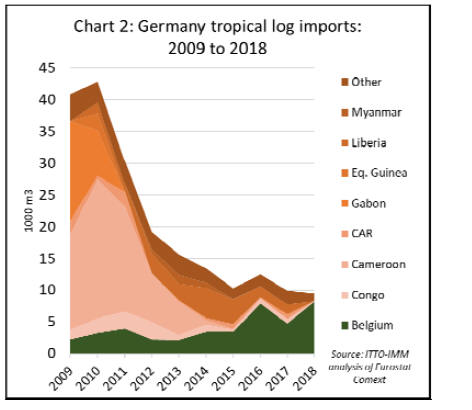
Germany¡¯s total imports of sawnwood increased from 5.0
million m3 in 2017 to 5.4 million m3 last year. This builds
on a long-term upward trend which has seen Germany¡¯s
sawnwood imports increased by over 40% in the last
decade.
85% of these imports comprise softwoods, and 67% is
from other EU countries. Nearly all the sawnwood
imported into Germany from outside the EU is from just
three countries; Belarus, Russia and Ukraine.
The rise in Germany¡¯s timber imports in 2018 comes
despite domestic softwood sawnwood production hitting
an all-time high of around 23 million m3 last year. The
signs are that total demand for sawnwood in Germany is
¡°red hot¡± at present.
However, this is not at all reflected Germany¡¯s tropical
sawnwood imports which have been declining (Chart 3).
Germany¡¯s imports of tropical sawnwood were only
around 73,000 m3 in 2018, a slight improvement on the
67,000 m3 imported the previous year, but well down on
103,000 m3 imported in 2016 and around half the level
prevailing a decade ago.
As in the log trade, there was a significant rise in indirect
imports via Belgium between 2009 and 2016, at the
expense of both direct imports from tropical countries and
other indirect imports from the Netherlands. However, in
2017, there was also sharp reversal in Germany¡¯s imports
of tropical sawn timber via Belgium.
Germany imported 109,000 m3 of veneers in 2018, down
from 115,000 m3 the previous year. Around 70% came
from other EU countries and 34,000 m3 from outside the
EU. Imports from other EU countries have been rising in
recent years as a large part of Germany¡¯s domestic
production has been relocated to lower cost locations in
Eastern Europe.
Meanwhile Germany¡¯s veneer imports from outside the
EU have fallen sharply, mainly due to a decline in imports
from the United States and Ivory Coast. This decline has
been only partially offset by a rise in imports from Russia
and Ukraine (Chart 4).

Germany¡¯s plywood imports have been rising in recent
years, peaking at 1.43 million m3 in 2018, of which
816,000 m3 was faced with hardwood and 615,000 m3
with softwood. Much of the recent growth in Germany¡¯s
plywood imports has comprised hardwood products
(mainly birch) from other EU countries and Russia (Chart
5).
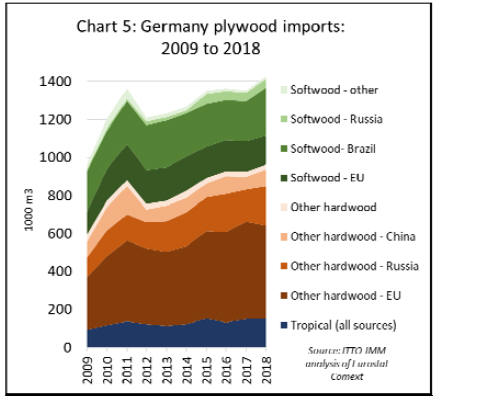
Despite stiff competition from birch plywood, tropical
hardwood plywood has made gains in Germany in recent
years, with total imports of tropical hardwood faced
plywood rising from less than 100,000 m3 a decade ago to
peak at 153,000 m3 in 2015. Imports fell back to 133,000
m3 in 2016 but rebounded to 150,000 m3 in 2017 and
remained at that level last year.
Much of the recent gain in Germany¡¯s tropical plywood
imports comprises products either manufactured using
tropical hardwoods in other EU countries, notably Italy
and Spain, or imported indirectly via these countries.
However, there has also been an increase in direct imports
of tropical hardwood plywood from Indonesia, from a low
of 20,000 m3 in 2013 to 31,000 m3 in 2018 (Chart 6).
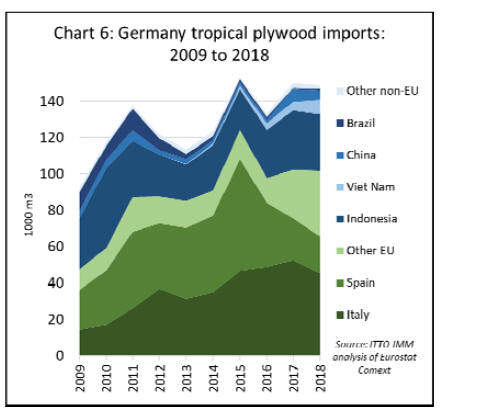
(classified under HS code 4409) increased sharply from
148,000 m3 in 2013 to 210,000 m3 last year. Nearly all
the gains were in softwood products from other EU
countries.
Germany¡¯s imports of these products from the tropics have
been edging downwards in recent years, from 42,000 m3
in 2015 to 40,000 m3 last year. Imports from Indonesia, by
far the largest tropical supplier to Germany, fell from
33,000 m3 to 28,000 m3 (Chart 7).
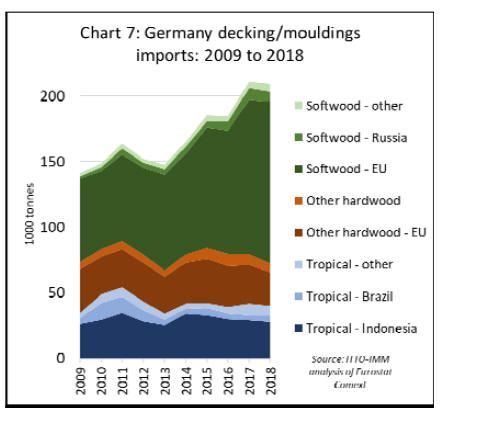
IMM Trade Consultation explores drivers of tropical
wood decline in Germany
Insights into the reasons for Germany¡¯s shift away imports
of tropical wood, particularly direct imports, were
provided by the IMM Trade Consultation held in Berlin at
the end of 2018.
This consultation forms part of wider series of
consultations being held during 2018 and 2019 in all the
main European markets for tropical wood products to
obtain feedback from the trade on the potential to develop
markets for FLEGT licensed timber in the EU.
During the Berlin consultation, to help place FLEGT
licensed timber in the correct market context, traders were
asked to identify and rank the key factors driving market
decline for tropical timber products in Germany in recent
years.
The main drivers identified, in declining order of
significance, were:
-
Substitution by temperate wood, composites and
other materials (16 votes);
-
Environmental prejudice and uncoordinated
marketing (9 votes);
-
Competition from China for material access and
in markets for finished goods (9 votes);
and
-
The
challenges of conformance to the EU Timber
Regulation (8 votes).
|
The first driver is indicated both by the trade flow
data,
which shows large increases in Germany¡¯s trade in wood
products other than tropical timber, and by other reports
from traders.
These reports highlight, for example, that all solid wood
products, but particularly tropical, are losing share to
wood plastic composites in the market for decking and
other exterior products.
This trend is so far-reaching in Germany that even
thermally and other treated temperate wood products,
which are making ground elsewhere in Europe, are losing
share in Germany.
Similarly, the market for real-wood flooring in Germany
has been struggling in recent times even as broader
domestic consumption trends have been on the rise, an
indication of the pressure being felt in this market from
alternatives such as laminated flooring and luxury vinyl
tiles.
The fourth driver of tropical wood¡¯s decline, relating to
EUTR, features more strongly in Germany than in other
EU countries. It is also reflected in the trade data which
shows the growing proportion of tropical wood imported
indirectly into Germany via other EU countries.
This tends to confirm reports that an increasing proportion
of tropical wood imports into the EU are now being
channelled via larger importing companies close to the
main European ports that are willing and able to devote
more time and resources for a wide range of specialist
services, including EUTR due diligence.
A feature of the Germany IMM trade consultation
(interestingly also repeated in a more recent Dutch/Belgian
IMM event held in Antwerp) is that while EUTR is
identified by the importing sector as a significant of driver
of decline in tropical wood trade, at the same time it is also
seen as a potentially important part of long-term strategy
to maintain and, potentially, rebuild market share.
Having rated drivers of market decline, German importers
at the consultation were then asked to rate the potential of
different market development strategies for tropical timber
in the EU. One strategy was rejected outright by all
participants; this proposed ¡°deregulation¡±, the total
abolition of requirements for EUTR and FLEGT licensing,
based on the assumption that tropical timber imports may
be boosted by reducing the regulatory burden.
Not only was the deregulatory approach rejected, but the
strategy receiving by far the most votes was the exact
opposite; ¡°a regulatory approach involving increased
supply of FLEGT-licensed tropical timber linked to
consistent and effective enforcement of EUTR to remove
illegal wood¡±.
Practically all participants in Berlin regarded the EUTR
combined with FLEGT licensing as the right approach to
improve credibility and reputation of the tropical timber
trade in the EU. The process of consolidation in the sector
and the concentration of import activities in the hands of a
smaller number of expert importers was also generally
seen as a positive development by participants.
The second most favoured strategy for rebuilding tropical
wood¡¯s market share in Germany was identified as
¡°highlighting/promoting the environmental benefits of
tropical timber and underpinning these scientifically
through life-cycle analysis (LCA)¡±.
Here, traders were also calling for increased regulatory
support through government procurement policies.
Participants at the trade consultation also called for
inclusion of FLEGT-licensed tropical timber in public
procurement policies as evidence of both legality and
sustainability.
While these strategies were seen as having potential to
improve market conditions for tropical wood in the
German market, trade consultation participants generally
expected stagnation of the German and wider EU tropical
timber market at the current low level, at least in the short
to medium term.
New resource on benefits of FLEGT-licensed products
Timber buyers can now visit a new webpage in English,
French, Italian or Spanish to learn about the business
benefits of trading in FLEGT-licensed timber and the
social, environmental and economic benefits that such
trade brings to producer countries.
The EU FLEGT Facility created the page ¡ª
www.timberbuyers.flegtlicence.org ¡ª to inform traders,
specifiers, architects and retailers, as well as sustainability
specialists and end consumers of timber products.
Combining text, pictures and an animated film, it
describes how the EU is working with tropical timberexporting
countries to stop illegal logging and promote
trade in legal timber products.
The new resource explains what FLEGT licenses are, how
they benefit timber buyers in the EU, and how the
advantages of FLEGT licensing extend far beyond legality
to encompass social, economic and environmental gains in
producer countries.
It includes links to multimedia stories that highlight the
benefits of FLEGT licensing, and to downloadable
resources that can help timber buyers to communicate
about FLEGT-licensed products with their customers.
The EFI FLEGT Facility, that developed the site, note that
¡°FLEGT-licensed timber products are best known for their
verified legality.
They automatically meet the requirements of the EU
Timber Regulation so, for operators in the EU, they
eliminate the risk of trading in illegal timber. Less wellknown
are the considerable social, economic and
environmental credentials of FLEGT-licensed products.
Yet the trade in these products, and the reforms and
improvements that stand behind the licenses, are helping
ensure that forests contribute to economic growth and
poverty reduction, while promoting responsible forest
management¡±.
The new webpage is part of the FLEGT license
information point, which the Facility set up in 2016 to
provide practical information about FLEGT licenses,
import procedures, trade scenarios and answers to
frequently asked questions.
European parquet flooring industry reports stable to
slightly positive trend
Compared to the same period last year, sales of wood
parquet flooring in the EU in the first quarter of 2019 were
stable or moderately increasing in all countries except
Belgium, the Netherlands, Switzerland and the UK which
reported limited declines.
The shortage of hardwood face material ¨C particularly oak
¨C which has been a significant problem in recent years,
seems to have eased so far in 2019. However, prices are
rising for panel products (HDF, plywood) used in the other
layers. These are the principal conclusion of the Board of
Directors of the European Federation of the Parquet
Industry (FEP) when they met on 4 April 2019 to discuss
the parquet market situation.
The FEP Board also provided the following insights into
current market conditions in each EU country in the first
quarter of 2019:
Austrian parquet sales were up 1% during the period:
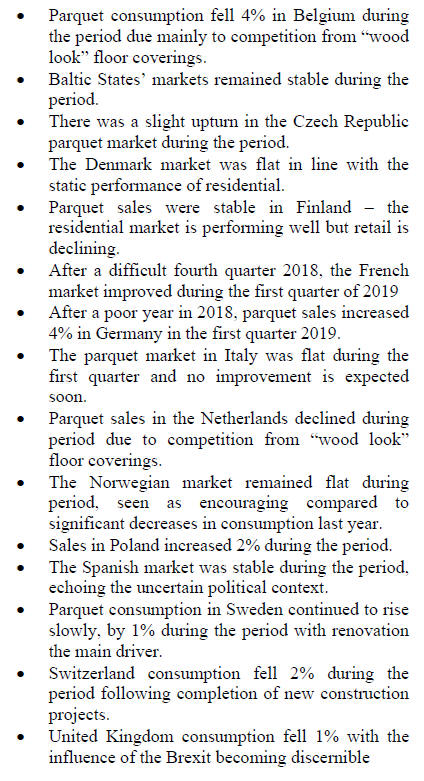
European company looks to expand supply of
acetylated wood in Asia
Accsys Technologies PLC has announced that its
subsidiary, Tricoya Technologies Limited (¡°TTL¡±), has
now entered into an agreement with Petronas Chemicals
Group Berhad (¡°PCG¡±) to evaluate the feasibility of
jointly funding, designing, building and operating an
integrated acetic anhydride and Tricoya wood elements
production plant in Malaysia.
It is envisaged that Tricoya wood elements produced at the
plant would use acetic acid from PCG¡¯s existing joint
venture in Malaysia. The plant would then supply the
wood panel industry within South East Asia, under
licence, as the key raw material for the formation of
Tricoya panels for the use in the construction industry in
the region.
The Malaysia feasibility study forms part of a wider
strategy to develop markets for products manufactured
using Accsys technology. Accsys Technologies PLC has
recently made multi-million dollar investments in a
Tricoya plant for annual production of up to 30,000 tonnes
per year of acetylated wood chips in Hull, England, and to
increase capacity of its Accoya production plant in
Arnhem, Netherlands, by 50% to 60,000 cubic metres.
Abbreviations
|
LM Loyale Merchant, a grade of log parcel |
Cu.m
Cubic Metre |
|
QS
Qualite Superieure |
Koku
0.278 Cu.m or 120BF |
|
CI
Choix Industriel
|
FFR
French Franc |
| CE Choix
Economique
|
SQ
Sawmill Quality |
|
CS Choix Supplimentaire |
SSQ
Select Sawmill Quality |
| FOB
Free-on-Board |
FAS
Sawnwood Grade First and |
| KD
Kiln Dry
|
Second |
| AD
Air Dry
|
WBP
Water and Boil Proof |
| Boule
A Log Sawn Through and Through |
MR
Moisture Resistant |
| the
boards from one log are bundled |
pc
per piece |
|
together |
ea
each |
| BB/CC
Grade B faced and Grade C backed |
MBF
1000 Board Feet
|
|
Plywood |
MDF
Medium Density Fibreboard |
| BF
Board Foot |
F.CFA CFA Franc
|
|
Sq.Ft
Square Foot |
  Price has moved up or down
Price has moved up or down |
|
